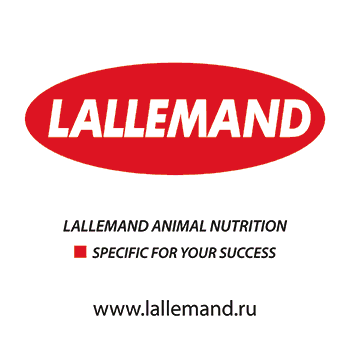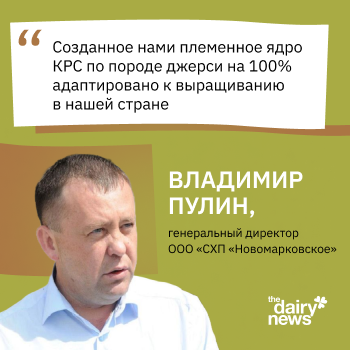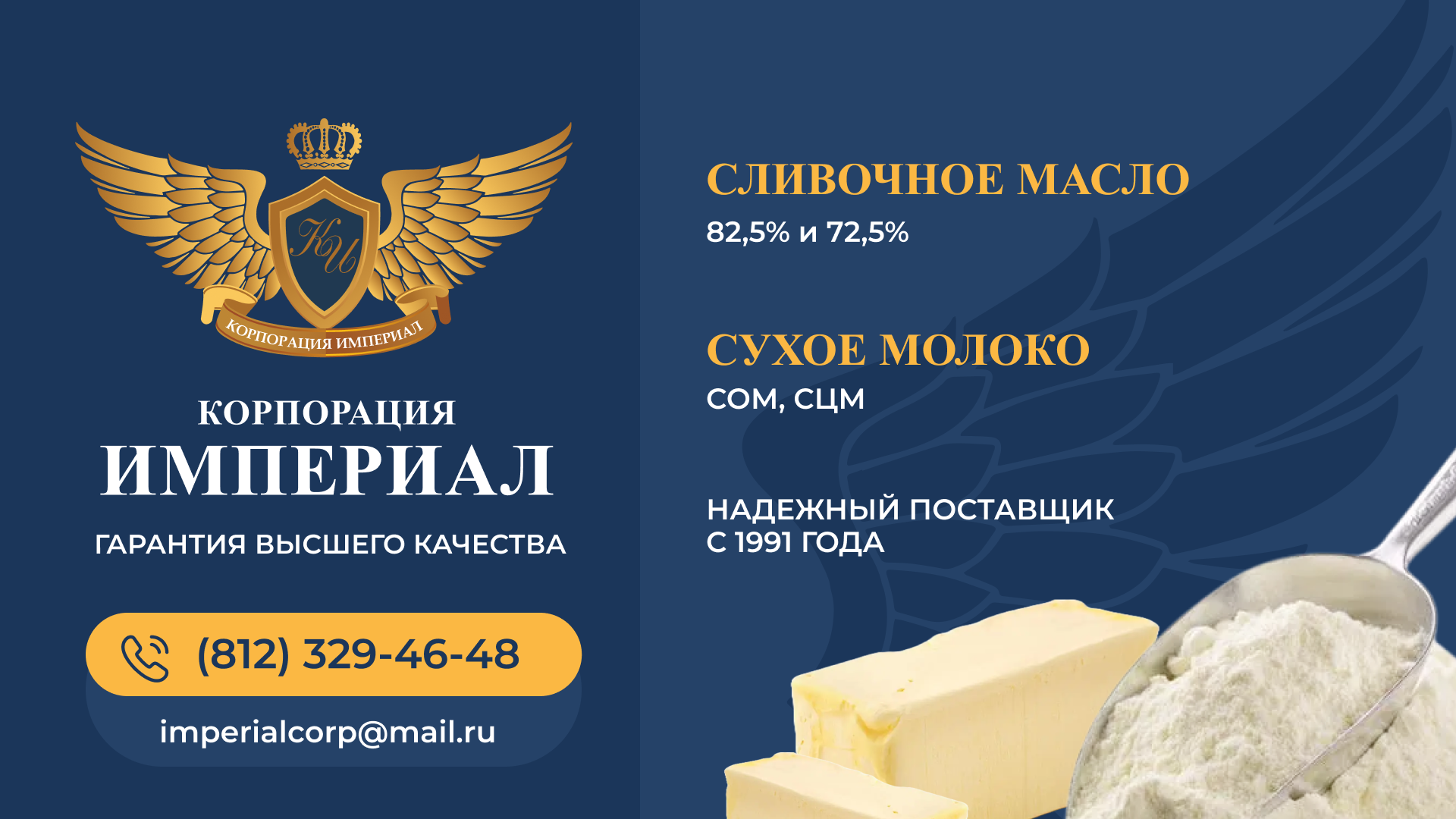Natural growth: dairy prices rise worldwide
Источник: The DairyNews
The Global Dairy Trade (GDT) price index, a measure of international milk commodity prices, has risen by 12,7%. The strongest growth was in WMP and dried buttermilk powder. What is it – coincidence or pattern of the economy?
Before growth
The difficult economic and political situation, China's economic growth will decline to 6.7 per cent, the weakening exchange rate of currencies against the U.S. dollar (USD), surplus conditions – all this has become the reasons that caused falling price to a record low. Many foreign farmers faced difficulties. For example, New Zealand's dairy farmers have had to sell their herds for slaughter in order to pay the bills.
Predictable growth
The Global Dairy Trade index rose by 12.7% last week. The experts of the dairy industry, which were questioned by The DairyNews, noted that this increase was predictable, because in many countries, recorded a sharp decrease in milk production. Preliminary data for European production suggests YOY production decline for June 2016 by 1.5% - largely driven by decreases in milk supply out of the UK, Italy, France and Germany. “Production growth is also declining in the US, and in South America.The effects of flooding in Argentina and the economic downturn will likely cause a double digit % drop in milk production”,- said Kevin Bellamy, Global Strategist - Dairy at Rabobank, in his comment for The DairyNews.
The Russian experts have similar views on this issue with foreign colleagues. “Now the market wins back their values. In addition, there are negative forecast for amount of production, related to bad weather conditions in the traditional “dairy” regions,” – suggested Yuri Vlasenko, marketing Director “PIR Product”.
Tatyana Rybalova, the independent expert of the dairy market, noted that “the main reason of GDT index growth has become an increasing China's growth”.
Preliminary forecast
It is too early to predict will be the prices rise further, but a recovery in the market is clearly there.
“In terms or farmers specifically, I think this will provide a sign of relief after a couple of very difficult years. While the prices are still below what many will need to be profitable, it is most certainly a step in the right direction”, - suggested Robbie Turner, the Head of European market in International Rice Dairy.
According to the USDA report (Ministry of agriculture), milk price will increase in 2017 and will reach $15,70 for 45kg, respectively, that is $ 0.35 for 1 kg . High domestic demand and improving market conditions will contribute to higher prices for all major dairy products.
“I am quite sure that prices will rise further, but I wouldn’t be surprised to see some temporary declines in prices along the way”, - said Mark Stephenson, the Director of Dairy Policy Analysis at the University of Wisconsin, Madison (USA).
We do not say that for farmers and processors came better times. Of course rising prices, according to many experts, would have a beneficial effect on all market participants.
As regards milk prices in Russia, we remind that in the framework of the MotorRally “Way for Milk!” the foreign expert Torsten Hemme said that “the milk prices in Russia may rise, because Russia's milk prices follow world prices”.
“The price of milk in Russia can grow up to 35 rubles/kg the next year, if only consumer is ready to buy at this price”,- the expert said during the meeting with representatives of the Ministry of the Saratov region.
The rising prices of dairy products noticed in worldwide and Russia was not an exception. This summer season of “big milk” in Russia was absent: the processors did not reduce the purchase prices. Experts predict a further increase in the prices of raw materials and final products.
DN: How do I assess the prices on the GDT?
K.B.: The GDT Event price index of course went up 12.7%. The average price was US$ 2,731 / tonne, last seen to October 2015 levels. This was an important auction because seasonal peak volumes were offered on this Event, with around 38,000 tonnes of dairy product sold. All of the product categories prices rose with WMP rising 18.9% bringing the average price to $2,695. The timing coensides with peak WMP volumes which were on offer for this GDT Event, at around 21,500 tonnes. SMP prices rose by a more modest increase (+3%) by comparison – this is not surprising given the volume of SMP sitting in intervention stocks in Europe.
There are a number of drivers influencing the GDT auction:
1) Increased buying from those trying to capture the bottom of the market while prices are relatively low.
2) Prices remain attractive to Chinese buyers (However, we are of the view that consumer demand is fragile in China and we expect powder imports to slow later in the year).
3) Domestic production in China is probably falling short in the summer season as what appeared as El Nino struggling with La Nina bringing very high temperatures in China although is is as yet unclear how badly the dairy production was affected. (While large scale corporate dairy farms tend to have cooling facilities to prevent heat stroke, small and medium farms do not and yields can be affected in a significantly by heat stroke).
Preliminary data for European production suggests YOY production decline for June 2016 by 1.5% - largely driven by decreases in milk supply out of the UK, Italy, France and Germany. The Netherlands and Ireland look to be in positive milk supply growth for June 2016, up 4.8% and 4.5% respectively.
Production growth is also declining in the US, and in South America the effects of flooding in Argentina and the economic downturn will likely cause a double digit % drop in milk production.
While the market does appear to have tightened prices remain 19% lower than the 5-year average.
DN: Will prices rise further?
K.B.: We expect prices to rise more as the balance between supply and demand tightens. Demand has been stronger in traditional dairy consumption regions and also in places like South East asia. International Oil prices recovering will also help demand. Supply growth is falling due to low prices and weather. But our modelling suggests that the ability of European farmers to increase production if prices recover will mean that the market may not hit the high prices seen in 2014. Unless of course there are some climatic or economic shocks affecting supply or demand. Our modelling suggests international whole milk prices of around US$3000 per tonne for WMP as we move into next year.
DN: How does it affect players in the dairy sector?
K.B.: Over time the higher prices will be passed bac k to farmers – which in turn may stimulate higher supplies.
From a processor point of view there is a need to consider when to sell (or hold in stock) and at what price to sell.
Most anticipate the prices will rise so sellers hold product back – buyers seek to buy early.
The difficulty in passing on raw material price rises to consumers means it may be a challenging time.
DN: How do you assess the growth of prices on stock exchange Global Dairy Trade?
M.S.: The big rise that we have seen in the GDT numbers has been expected, we just didn’t know with certainty when it would happen. Milk production around the globe has been reacting to low milk prices caused by too much supply, softening demand, and increasing inventories of dairy products. Farmers have finally begun to slow down their production of milk and the growth in demand has surpassed the growth in milk supply which means that we can begin to draw down inventories of product. I think that buyers around the world have reacted to this by purchasing more dairy products before prices rise further.
DN: Will the prices rise further?
M.S.: I am quite sure that prices will rise further, but I wouldn’t be surprised to see some temporary declines in prices along the way. We still have quite a bit of world inventory of storable dairy products to reduce before we can have a sustained surge in product prices. I think that the 12,7% increase was a jump by folks who believe that we have seen the bottom. It is worth noting that we have seen bigger increases than this at the beginning of 2015 and again in the middle of 2015. The markets are testing the prices to see if the price rise is warranted.
DN: How do the rise of price affect participants of dairy industry (farmers, processing companies)?
M.S.: Farmers around the globe have had a sustained period of low milk prices. The impacts have not been the same everywhere, but they have been bad. For instance, the U.S. farm milk prices have held up better then milk prices in the EU, and the EU prices have been better than prices in New Zealand. But, farms across the globe have been having problems with low milk prices.
Dairy processing companies can enjoy relatively lower milk prices, but the reason they are low is because product sales have not been as good as they would hope for. Sales to China have improved, but the growth is slower than we have come to expect. Many oil exporting countries have seen their economies depressed and have been unable to afford purchases of as much dairy product as they were previously consuming. Strong dairy product sales will always stimulate higher milk prices, so the well-being of processing companies and farmers are closely tied.
DN: How do you assess the growth of prices on stock exchange Global Dairy Trade?
R.T.: In my view, Tuesday’s GDT exceeded expectations, and caught many by surprise. While the expectation was for another strong event – as indicated by the NZX futures – I don’t think many in the market anticipated WMP being so strong, or butter for that matter. SMP was closer to where the market was expecting the auction to settle.
DN: Will the prices rise further?
R.T.: My view is that prices will continue to strengthen, though perhaps not as aggressively as we saw on Tuesday. Many buy-side participants have been servicing inventories, versus building them, and I think Tuesday was a bit of a wakeup call for those who are unhedged to secure product before we run again.
DN: How do the rise of price affect participants of dairy industry (farmers, processing companies)?
R.T.: On the whole this is a positive for famers and sellers as it shows we have well and truly come up for the bottom, and that all the surplus supply (both in Oceania and the EU) has been worked through (we see this in the EU with the strengthening SMP and butter prices, and the SMP Intervention volumes falling). I would be cautious about expecting future GDTs to be so aggressive, but I certainly see more upside than downside. In terms or farmers specifically, I think this will provide a sign of relief after a couple of very difficult years. While the prices achieve are still below what many will need to be profitable, it is most certainly a step in the right direction.
DN: How do you assess the growth of prices on stock exchange Global Dairy Trade?
R.B.: The prices of milk commodities, after the end of quota system, take shape in Europe. NZ and GDT are only following the trend started in Europe two mounths ago after the beginnig of milk production reduction depending on the low farm gate prices.
The EU and national governments have no role in this recovering of prices. The market today is much more healthy and it works. The volatility will continue to be in the near future very strong. It is necessary that dairies and processors transmit the prices movements as fast as possible, in both directions, up and now.
DN: Will the prices rise further?
R.B.: Of course! Expecially the prices of products still in delay, like cheeses and smp.
DN: How do the rise of price affect participants of dairy industry (farmers, processing companies)?
R.B.: Will be good for farmers after one year very tough, for processors is now necessary to increase very rapidly and strongly the selling prices. If not, will be dagerous.
The difficult economic and political situation, China's economic growth will decline to 6.7 per cent, the weakening exchange rate of currencies against the U.S. dollar (USD), surplus conditions – all this has become the reasons that caused falling price to a record low. Many foreign farmers faced difficulties. For example, New Zealand's dairy farmers have had to sell their herds for slaughter in order to pay the bills.
Predictable growth
The Global Dairy Trade index rose by 12.7% last week. The experts of the dairy industry, which were questioned by The DairyNews, noted that this increase was predictable, because in many countries, recorded a sharp decrease in milk production. Preliminary data for European production suggests YOY production decline for June 2016 by 1.5% - largely driven by decreases in milk supply out of the UK, Italy, France and Germany. “Production growth is also declining in the US, and in South America.The effects of flooding in Argentina and the economic downturn will likely cause a double digit % drop in milk production”,- said Kevin Bellamy, Global Strategist - Dairy at Rabobank, in his comment for The DairyNews.
The Russian experts have similar views on this issue with foreign colleagues. “Now the market wins back their values. In addition, there are negative forecast for amount of production, related to bad weather conditions in the traditional “dairy” regions,” – suggested Yuri Vlasenko, marketing Director “PIR Product”.
Tatyana Rybalova, the independent expert of the dairy market, noted that “the main reason of GDT index growth has become an increasing China's growth”.
Preliminary forecast
It is too early to predict will be the prices rise further, but a recovery in the market is clearly there.
“In terms or farmers specifically, I think this will provide a sign of relief after a couple of very difficult years. While the prices are still below what many will need to be profitable, it is most certainly a step in the right direction”, - suggested Robbie Turner, the Head of European market in International Rice Dairy.
According to the USDA report (Ministry of agriculture), milk price will increase in 2017 and will reach $15,70 for 45kg, respectively, that is $ 0.35 for 1 kg . High domestic demand and improving market conditions will contribute to higher prices for all major dairy products.
“I am quite sure that prices will rise further, but I wouldn’t be surprised to see some temporary declines in prices along the way”, - said Mark Stephenson, the Director of Dairy Policy Analysis at the University of Wisconsin, Madison (USA).
We do not say that for farmers and processors came better times. Of course rising prices, according to many experts, would have a beneficial effect on all market participants.
As regards milk prices in Russia, we remind that in the framework of the MotorRally “Way for Milk!” the foreign expert Torsten Hemme said that “the milk prices in Russia may rise, because Russia's milk prices follow world prices”.
“The price of milk in Russia can grow up to 35 rubles/kg the next year, if only consumer is ready to buy at this price”,- the expert said during the meeting with representatives of the Ministry of the Saratov region.
The rising prices of dairy products noticed in worldwide and Russia was not an exception. This summer season of “big milk” in Russia was absent: the processors did not reduce the purchase prices. Experts predict a further increase in the prices of raw materials and final products.
Comments of experts:

|
Kevin Bellamy, Global Strategist – Dairy, Rabobank |
DN: How do I assess the prices on the GDT?
K.B.: The GDT Event price index of course went up 12.7%. The average price was US$ 2,731 / tonne, last seen to October 2015 levels. This was an important auction because seasonal peak volumes were offered on this Event, with around 38,000 tonnes of dairy product sold. All of the product categories prices rose with WMP rising 18.9% bringing the average price to $2,695. The timing coensides with peak WMP volumes which were on offer for this GDT Event, at around 21,500 tonnes. SMP prices rose by a more modest increase (+3%) by comparison – this is not surprising given the volume of SMP sitting in intervention stocks in Europe.
There are a number of drivers influencing the GDT auction:
1) Increased buying from those trying to capture the bottom of the market while prices are relatively low.
2) Prices remain attractive to Chinese buyers (However, we are of the view that consumer demand is fragile in China and we expect powder imports to slow later in the year).
3) Domestic production in China is probably falling short in the summer season as what appeared as El Nino struggling with La Nina bringing very high temperatures in China although is is as yet unclear how badly the dairy production was affected. (While large scale corporate dairy farms tend to have cooling facilities to prevent heat stroke, small and medium farms do not and yields can be affected in a significantly by heat stroke).
Preliminary data for European production suggests YOY production decline for June 2016 by 1.5% - largely driven by decreases in milk supply out of the UK, Italy, France and Germany. The Netherlands and Ireland look to be in positive milk supply growth for June 2016, up 4.8% and 4.5% respectively.
Production growth is also declining in the US, and in South America the effects of flooding in Argentina and the economic downturn will likely cause a double digit % drop in milk production.
While the market does appear to have tightened prices remain 19% lower than the 5-year average.
DN: Will prices rise further?
K.B.: We expect prices to rise more as the balance between supply and demand tightens. Demand has been stronger in traditional dairy consumption regions and also in places like South East asia. International Oil prices recovering will also help demand. Supply growth is falling due to low prices and weather. But our modelling suggests that the ability of European farmers to increase production if prices recover will mean that the market may not hit the high prices seen in 2014. Unless of course there are some climatic or economic shocks affecting supply or demand. Our modelling suggests international whole milk prices of around US$3000 per tonne for WMP as we move into next year.
DN: How does it affect players in the dairy sector?
K.B.: Over time the higher prices will be passed bac k to farmers – which in turn may stimulate higher supplies.
From a processor point of view there is a need to consider when to sell (or hold in stock) and at what price to sell.
Most anticipate the prices will rise so sellers hold product back – buyers seek to buy early.
The difficulty in passing on raw material price rises to consumers means it may be a challenging time.
 |
Mark Stephenson, the Director of Dairy Policy Analysis at the University of Wisconsin, Madison |
DN: How do you assess the growth of prices on stock exchange Global Dairy Trade?
M.S.: The big rise that we have seen in the GDT numbers has been expected, we just didn’t know with certainty when it would happen. Milk production around the globe has been reacting to low milk prices caused by too much supply, softening demand, and increasing inventories of dairy products. Farmers have finally begun to slow down their production of milk and the growth in demand has surpassed the growth in milk supply which means that we can begin to draw down inventories of product. I think that buyers around the world have reacted to this by purchasing more dairy products before prices rise further.
DN: Will the prices rise further?
M.S.: I am quite sure that prices will rise further, but I wouldn’t be surprised to see some temporary declines in prices along the way. We still have quite a bit of world inventory of storable dairy products to reduce before we can have a sustained surge in product prices. I think that the 12,7% increase was a jump by folks who believe that we have seen the bottom. It is worth noting that we have seen bigger increases than this at the beginning of 2015 and again in the middle of 2015. The markets are testing the prices to see if the price rise is warranted.
DN: How do the rise of price affect participants of dairy industry (farmers, processing companies)?
M.S.: Farmers around the globe have had a sustained period of low milk prices. The impacts have not been the same everywhere, but they have been bad. For instance, the U.S. farm milk prices have held up better then milk prices in the EU, and the EU prices have been better than prices in New Zealand. But, farms across the globe have been having problems with low milk prices.
Dairy processing companies can enjoy relatively lower milk prices, but the reason they are low is because product sales have not been as good as they would hope for. Sales to China have improved, but the growth is slower than we have come to expect. Many oil exporting countries have seen their economies depressed and have been unable to afford purchases of as much dairy product as they were previously consuming. Strong dairy product sales will always stimulate higher milk prices, so the well-being of processing companies and farmers are closely tied.
 |
Robbie Turner, Head of European markets, Rice Dairy International LTD |
DN: How do you assess the growth of prices on stock exchange Global Dairy Trade?
R.T.: In my view, Tuesday’s GDT exceeded expectations, and caught many by surprise. While the expectation was for another strong event – as indicated by the NZX futures – I don’t think many in the market anticipated WMP being so strong, or butter for that matter. SMP was closer to where the market was expecting the auction to settle.
DN: Will the prices rise further?
R.T.: My view is that prices will continue to strengthen, though perhaps not as aggressively as we saw on Tuesday. Many buy-side participants have been servicing inventories, versus building them, and I think Tuesday was a bit of a wakeup call for those who are unhedged to secure product before we run again.
DN: How do the rise of price affect participants of dairy industry (farmers, processing companies)?
R.T.: On the whole this is a positive for famers and sellers as it shows we have well and truly come up for the bottom, and that all the surplus supply (both in Oceania and the EU) has been worked through (we see this in the EU with the strengthening SMP and butter prices, and the SMP Intervention volumes falling). I would be cautious about expecting future GDTs to be so aggressive, but I certainly see more upside than downside. In terms or farmers specifically, I think this will provide a sign of relief after a couple of very difficult years. While the prices achieve are still below what many will need to be profitable, it is most certainly a step in the right direction.
 |
Roberto Brazzale, the owner of holding «Brazzale» (Italy, Czech Republic, China, Brazil), Chairman of the Dairy Czech-Moravian Association |
DN: How do you assess the growth of prices on stock exchange Global Dairy Trade?
R.B.: The prices of milk commodities, after the end of quota system, take shape in Europe. NZ and GDT are only following the trend started in Europe two mounths ago after the beginnig of milk production reduction depending on the low farm gate prices.
The EU and national governments have no role in this recovering of prices. The market today is much more healthy and it works. The volatility will continue to be in the near future very strong. It is necessary that dairies and processors transmit the prices movements as fast as possible, in both directions, up and now.
DN: Will the prices rise further?
R.B.: Of course! Expecially the prices of products still in delay, like cheeses and smp.
DN: How do the rise of price affect participants of dairy industry (farmers, processing companies)?
R.B.: Will be good for farmers after one year very tough, for processors is now necessary to increase very rapidly and strongly the selling prices. If not, will be dagerous.
Популярные темы
05.04.2024
В России резко сократилось количество импортных ветпрепаратов. Часть хозяйств используют запасы, другие переходят на отечественные аналоги. Российские производители наращивают производство и выводят на рынок новые препараты. Участники отрасли поделились с The DairyNews мнениями о текущей ситуации с ветпрепаратами и перспективах импортозамещения в этом сегменте.
Читать полностью
15.04.2024
Dairy Index DIA вырос на шесть копеек
01.04.2024
Dairy Index DIA вырос на три копейки








